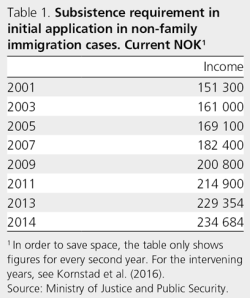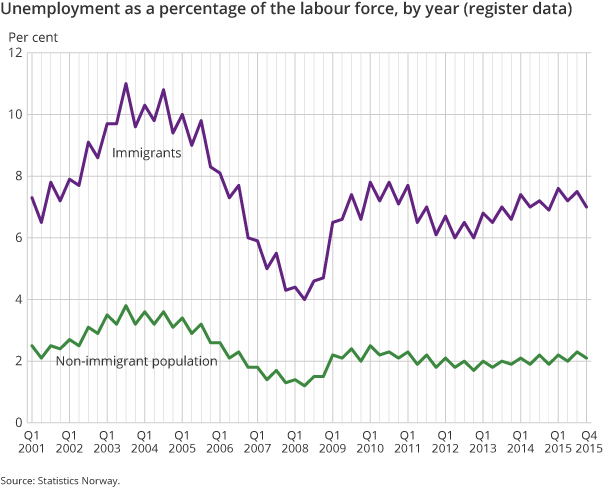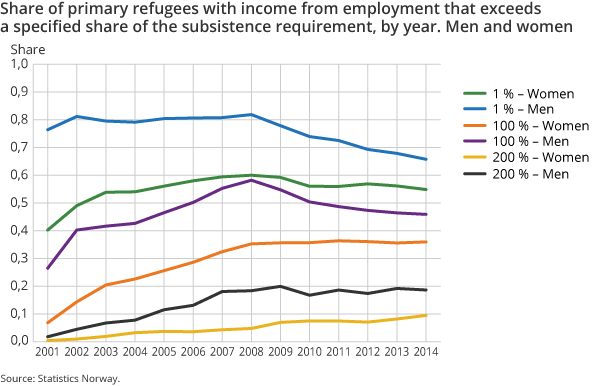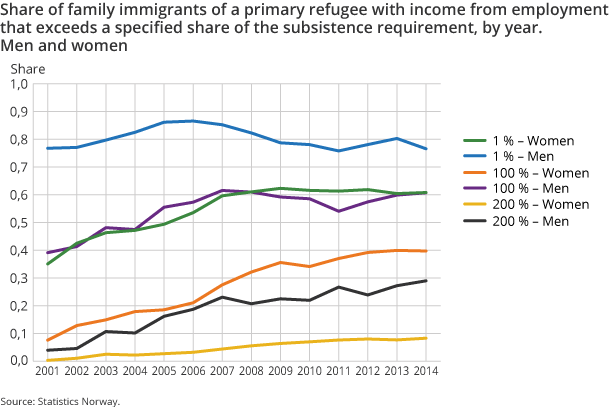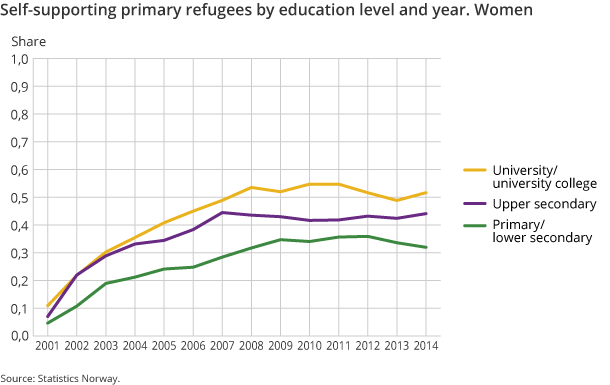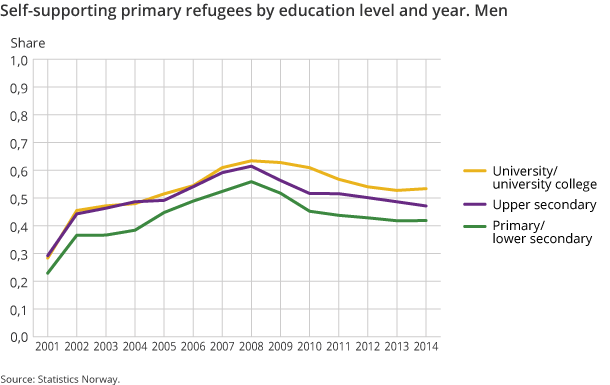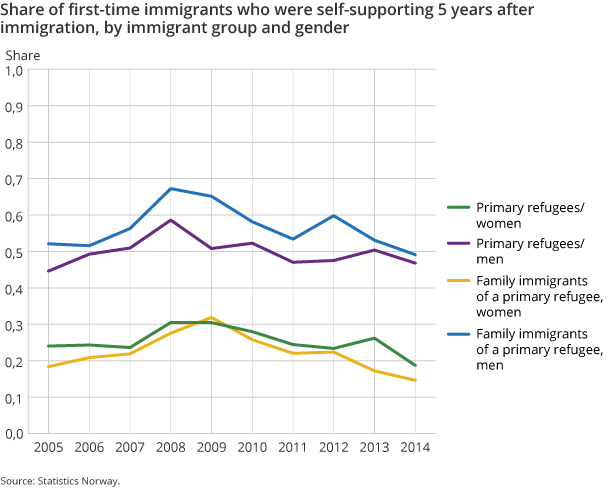Statistical analysis, 2017
Immigrants with a refugee background who arrived in Norway in 2000
6 in 10 men self-supporting after 8 years
Published:
This article was first published in Norwegian, in Statistics Norway’s journal Samfunnsspeilet: Kornstad, Tom (2016): Innvandrere med flyktningbakgrunn som kom til Norge i 2000. 6 av 10 menn selvforsørget etter 8 år. Samfunnsspeilet 4/2016. Statistisk sentralbyrå.
The incomes of refugees who came to Norway in 2000 have increased in line with their length of residence, but this trend has gradually come to a halt, especially among men. Almost 60 per cent of the men were self-supporting after eight years, then this figure subsequently declined. The pattern is the same regardless of education level. Among the women, the share peaked after eight years at around 35 per cent.
- Series archive
- Statistical analysis, 2017
Refugees’ ability to support themselves financially is a challenge for both society and the individual concerned. Refugees are granted residence in Norway based on their need for protection, therefore obtaining a residence permit does not entail a requirement to be self-supported. Nevertheless, it is pertinent to study whether refugees who have been granted residence can support themselves in the years following their arrival in the country.
We follow the group of primary refugees and family immigrants of a primary refugee who came to Norway for the first time in 2000, and observe their income every year up to and including 2014. Comparisons with statutory rates for minimum incomes for self-support show the development in the self-support rate over time.
Education and length of residence are key, as are gender and background
The analysis in this article is based on a previous study of self-support among non-Nordic immigrants (Kornstad et al. 2016). We examine immigrants who were aged 23–45 when they arrived in Norway. The lower age limit is set at 23 in order to form a clearer picture of the effects of immigrants’ education at arrival on their ability to support themselves financially.
When we break down the immigrants into groups by reason for immigration, education level and gender we find great disparities in the various groups’ self-support rates, by length of residence in Norway. Common to all the groups is that self-support increases considerably over time during the first years of living in Norway. It then appears to peak for many of the groups after around eight years. This is particularly the case for female refugees, but also female family immigrants of a primary refugee.
The self-support share for male family immigrants of a primary refugee also seems to peak. The correlation between length of residence and the self-support rate among male refugees, however, is somewhat different. For this group, we find that the self-support rate increases until about eight years of living in Norway before falling. This is also the case when we break down the male refugees by education level upon arrival.
Not surprisingly, refugees with a higher education have a higher self-support rate than refugees with a lower education, and this applies to both men and women. It is also important to distinguish between men and women when studying income distribution and self-support among immigrants with a refugee background. Women generally have a considerably lower self-support rate than men.
People with income from employment that exceeds the subsistence requirement are defined in the following as being self-supporting regardless of whether they work part time or full time. The growth in the subsistence requirement from 2001 to 2014 is about twice the growth in Statistics Norway’s consumer price index.
Income from employment includes income from wage earnings and (net) income from self-employment. Remuneration linked to the introduction programme for newly arrived immigrants that was introduced on 1 September 2003 is not classed as income from employment.
Employment and self-support – disparities in income limits
A number of studies have been conducted on immigrants’ incomes and financial integration over time. Studies that follow cohorts over time include Blom (2004, 2014), Østby (2001), Ekhaugen (2005), Bratsberg et al. (2011, 2010, 2016) and Barth et al. (2004). Of particular interest to us is Bratsberg et al. (2016), who study several immigrant cohorts with a refugee background and find a clear pattern among the men over time, where their employment increases during their first years in Norway, but starts to reverse after 7–10 years, with the rates showing a marked decline.
This finding applies to several immigrant cohorts, and the decline does not appear to be linked to a particular economic situation, for instance the financial crisis in 2007–2008. The fall in employment after a few years coincides with our findings on self-support among male refugees.
The subsistence requirement we use is almost three times as high as the income requirement for being employed in Bratsberg et al. – which is a considerable difference. We use the income limits as a measurement of standard of living and not as a measure of the income required to obtain a residence permit.
The actual income needed to be deemed self-supporting partly depends on family size and family composition, as well as the incomes of the other family members. The variation in housing costs across the country also means that place of residence will have a bearing on living expenses. This analysis does not factor in these complicating elements and instead uses the same income limit universally.
Composition of the 2000 immigration group
Our sample consists of some 5 200 immigrants aged 23–45 that arrived in Norway first time in 2000. More than four out of five in the sample are primary refugees (4 350), and about two out of three are men. Among the primary refugees, around four out of five are men, while among family immigrants of a primary refugee, it is the women who dominate, with a share of three out of four. Immigrants/refugees are often relatively young when they come to Norway – most are in their 20s and early 30s. This is also the case for the family immigrants we have analysed, and the age distribution is very similar for both immigrant groups.
The population is made up of refugees and family immigrants of a primary refugee who originally came to Norway first time in 2000 aged 23–45, and who are registered as resident in Norway at the end of this year. This population is followed over time, for each year up to the end of 2014, and only those who are registered as resident in Norway at the end of the relevant year are included in the analysis. Refugees do not often emigrate from Norway, which means in practice that the year dimension in our figures is equal to the length of residence in Norway (Kornstad, Stambøl and Skjerpen 2016).
A retrospective look at 2000 allows us to study the integration in the labour market over time. Persons under the age of 23 are excluded since we want to see if there are systematic disparities in the degree of self-support among refugees who have low and high levels of education respectively when they arrive in Norway. The upper age limit is set at 45 because when someone who is aged 45 in 2000 is followed over a period of 14 years, they will be approaching the age of early retirement at the end of the observation period.
Among the men, there is a significant predominance of refugees from Iraq (66 per cent) and Somalia (11 per cent). There is also a large representation of female immigrants from Iraq (23 per cent) and Somalia (22 per cent), but for the women the concentration from these countries is smaller as some also come from Iran, Afghanistan, Bosnia, Kosovo and Vietnam.
Few have a higher education
Among primary refugees, primary or lower secondary is the highest level of education for around one-third, while one in five (20 per cent) have an upper secondary education. This is the case when we only look at the group who were aged 23 or over when they came to Norway. Almost one in four men and one in five women have a university/university college education. Around one in ten of the female primary refugees have no education, while almost none of the men are registered as having no education.
As mentioned in the box explaining the data source, we do not have information on education for all immigrants. The problem is relatively minor for primary refugees, as we know the education of about four out of five men and women. For family immigrants of a primary refugee, the problem is so extensive that we are unable to examine the level of education of this group any further.
Economic downturns have a greater impact on immigrants
So far, we have looked at the characteristics of the immigrant group we will follow over time. In order to better understand how their participation in the labour market changes over time, it is pertinent to consider the state of the labour market during the relevant period.
Two features in particular can be observed. The first is the significant increase in the unemployment rate from around 2008 that followed the major fall from around 2003 to 2008. This increase coincided with the financial crisis (see Figure 1). The second is that when unemployment increases, the increase is disproportionately higher for immigrants than for the rest of the population. Immigrants are therefore harder hit during economic downturns, and it is more difficult for them to find paid work when times are hard. There are many reasons for this, one of which is that the distribution of employed immigrants across the different industries is not the same as for the rest of the population.
In addition to the observed effect on the unemployment rate, economic downturns also have a more hidden effect; the so-called ‘discouraged worker effect’, where the labour available fluctuates according to the state of the economy. An analysis by Dagsvik et al. (2016) on Norwegian data shows that relatively more immigrants withdraw from the labour market during economic downturns than people born in Norway, since they do not believe they will find work. Immigrants from Asia and Africa are more susceptible to fluctuations in economic activity and the hidden unemployment/discouraged worker effect is larger than for people born in Norway.
Financial independence among female refugees increases with length of residence
In order to analyse the income distribution for the 2000 cohort of immigrants, we measure income as a share of the subsistence requirement and not as a share of the total income level in society. We examine the share of persons with income from employment above 1 per cent, 100 per cent (self-supporting) and 200 per cent of the subsistence requirement, respectively. Observing the different shares over time gives us an insight into the development of the income distribution.
For the primary refugees who immigrated in 2000, we find that the share of self-supporting women increases the longer they stay in Norway, from about 10 per cent in 2001 to roughly 35 per cent in the period 2008–2014. Thus, among female primary refugees who came to Norway in 2000, only about one in three have sufficient income from employment to support themselves after more than eight years in the country.
We therefore find that female refugees typically belong to the low-income groups in society, even although a few have a high income. The share of female refugees with incomes twice as high as the subsistence requirement increases steadily throughout the reference period, up to around 10 per cent in 2014 (see Figure 2a). Horgen (2014) provides a description of the income situation among a group of immigrants with a weak attachment to the labour market.
Self-support among men increases with length of residence, before levelling off
Among male refugees, the development over time is somewhat different to that found for women. The self-support rate for men increases from around 40 per cent in 2002 to almost 60 per cent in 2008, before gradually falling to about 45 per cent in 2014.
The reasons for this development among male refugees are unclear. As already mentioned, Bratsberg et al. (2016) found that the employment rate among male refugees sees a clear fall after 7–10 years in Norway, even among immigrant cohorts that are not affected by the financial crisis at this point. There is reason to believe that this finding will also largely be applicable in the analysis of self-support. We do not, therefore, have any basis to conclude that the economic situation is the main reason behind the observed decline in the self-support rate after 2008.
Otherwise, we find that male refugees generally earn more than their female counterparts. In the second half of the reference period, almost one in five men earned more than double the subsistence requirement, compared with fewer than one in ten women.
Slightly more family immigrants self-supporting after 14 years
Male family immigrants of a primary refugee also earn more than their female counterparts, despite the incidence of high-income earners and low-income earners in both groups. Overall, the share of self-supporting female family immigrants of a primary refugee is about the same as for female refugees.
The share of self-supporting men among family immigrants shows a more stable development in the second half of the reference period than for male refugees, and is at a slightly higher level, at around 60 per cent. The share of men with high incomes (twice the subsistence requirement) at the end of the reference period is somewhat higher for family immigrants than for refugees. For women, there is little disparity in the shares that fall under the high-income group (see Figure 2b).
Higher education leads to higher incomes regardless of gender
A higher level of education is often associated with higher hourly rates of pay. However, it is often the case that the return on education is lower for immigrants than for people born in Norway, see Dagsvik et al. (2016). Hourly rates have two effects on employees’ income. Higher hourly rates mean a higher income per hour worked. In addition, higher hourly rates might increase labour supply (hours of work) of the individual. Our findings for refugees support these arguments. A high level of education upon arrival in Norway is associated with a greater self-support rate for both women and men.
Again, it is important to distinguish between women and men. Women with only a primary or lower secondary education stand out as having the lowest self-support rate, with about 35 per cent at the most. Men with a primary or lower secondary education experienced strong growth in self-support until around 2008, after which the share fell to 40 per cent in 2014. The pattern of initially rising and then falling is common to all three educational levels for the men in the analysis, including those with the highest levels of education (see Figures 3a and 3b).
In relation to refugees with a university and/or university college education, the self-support rate among women is considerably lower than for men during their first years in Norway. Since women do not have the same decline in the self-support rate in the second part of the period as men, the self-support rate in the years 2011–2014 is roughly the same for women and men with a high level of education.
More difficult for those who arrived after 2003?
A generalisation of the findings of the analysis so far identifies a weakness in that there can be systematic disparities between different immigrant cohorts. This may be due to the composition of the immigrant groups in different years, but may also be a result of economic conditions. For example, it is likely that immigrants who come to Norway during an economic downturn will find it more difficult to gain a foothold in the labour market both in the short and long term than those arriving when the economy is doing well.
One way of dealing with this is to follow several immigrant cohorts over time to see if there are systematic disparities between the different cohorts. In this analysis, we have followed, over time, the immigrants who came to Norway in the years 2000–2009, and looked at the self-support rates five years after they first arrived. The sample of immigrants has been selected in the same way as before, with one exception. We can increase the age range of 23–45 to 18–55 without the oldest group reaching retirement age in the last year of observation. By also reducing the lower age limit, we capture more immigrants than previously. As before, we are interested in the share of immigrants that are self-supporting (see box).
One interesting finding is the large degree of similarity in the development of self-support rates over time for refugees and family immigrants of a primary refugee. For both groups we find a clear trend where the self-support rate five years after the initial immigration increases until around 2008 and then falls (see Figure 4).
If we consider this pattern in relation to the increased immigration to Norway in the second half of the 2000s, partly as a result of the expansion of the EU, it is tempting to speculate that this pattern emerges because increasing immigration leads to greater pressure in the labour market, particularly for those with the poorest qualifications. This group will subsequently be pushed out of the labour market and their degree of self-support will fall.
Typical pattern with no clear reason
Over a 14-year period, we have followed immigrants who originally arrived as refugees in Norway in 2000, and examined how their degree of self-support has changed during this time. The degree of self-support has been primarily measured by whether the immigrants earn at least as much as the subsistence requirement upon initial application in non-family immigration cases, but we have also looked at the income distribution. Immigrants with a refugee background often belong to the low-income groups in society, and that is particularly the case for women.
The analysis also shows a typical pattern where self-support increases with length of residence in Norway until about eight years. Several of the groups in the analysis peak at this point, which may indicate that their integration into the labour market comes to a halt for some reason.
Men who came to Norway as refugees are distinct in that their self-support starts to decline quite sharply after about eight years in Norway. This finding is supported by other studies that examine several immigrant cohorts, but which analyse labour force participation as opposed to self-support as in this study. The reason for this pattern is unclear, and more insight is needed into the mechanisms behind the finding.
References
Barth, E., Bratsberg, B. & Raaum, O. (2004). Identifying earnings assimilation of immigrants under changing macroeconomic
conditions. Scandinavian Journal of Economics, 106(1), 1-22. Retrieved from
http://dx.doi.org/10.1111/j.0347-0520.2004.t01-1-00345.x
Blom, S. (2004). Labour market integration of refugees in Norway under changing macro-economic conditions. Journal of International Migration and Integration, 5(1), 1-31. Retrieved from
http://dx.doi.org/doi:10.1007/s12134-004-1000-3
Blom, S. (2014). Sysselsetting og økonomiske overføringer blant sju ankomstkohorter av innvandrere observert i perioden 1993-2010 (Reports 2014/38). Retrieved from:
http://www.ssb.no/arbeid-og-lonn/artikler-og-publikasjoner/_attachment/208004
Bratsberg, B., Røed, K. & Raaum, O. (2010). When minority labour migrants meet the welfare state. Journal of Labor Economics, 28(3), 633-676. Retrieved from: http://dx.doi.org/10.1086/650546
Bratsberg, B., Røed, K. & Raaum, O. (2011). Yrkesdeltaking på lang sikt blant ulike innvandrergrupper i Norge (Report 1/2011). Oslo: Stiftelsen Frischsenteret for samfunnsøkonomisk forskning
Bratsberg, B., Raaum, O. & Røed, K. (2016). Flyktninger på det norske arbeidsmarkedet, Søkelys på arbeidslivet, 33(3), 185-207. Retrieved from: https://www.idunn.no/spa/2016/03/flyktninger_paa_det_norske_arbeidsmarkedet
Dagsvik, J. K., Kornstad, T. & Skjerpen, T. (2016). Discouraged worker effects and barriers against employment for immigrant and non-immigrant women (Discussion papers 845). Retrieved from: http://www.ssb.no/en/forskning/discussion-papers/_attachment/276889
Horgen, E. H. (2014). Innvandrere med svak tilknytning til arbeidsmarkedet - hvem er de? (Reports 2014/22). Retrieved from: http://www.ssb.no/arbeid-og-lonn/artikler-og-publikasjoner/_attachment/180569
Kornstad, T., Skjerpen, T. & Stambøl, L. S. (2016). Utvandring blant innvandrere I Norge. Del 2: Analyser basert på mikrodata (Rapporter 2016/27). Retrieved from: https://www.ssb.no/befolkning/artikler-og-publikasjoner/_attachment/278286
Kornstad, T., T. Skjerpen & K. Telle (2016). Selvforsørging etter botid blant ikke-nordiske innvandrere. Økonomiske analyser 4/2016, 37-47. Statistics Norway. Retrieved from: https://www.ssb.no/inntekt-og-forbruk/artikler-og-publikasjoner/selvforsorging-etter-botid-blant-ikke-nordiske-innvandrere
Ekhaugen, T. (2005). Immigrants on welfare: Assimilation and benefit substitution (Memorandum Familieinnvandrere til primærflyktninger, nr. 18/2005). Økonomisk institutt, Universitetet i Oslo. Retrieved from: http://www.sv.uio.no/econ/english/research/unpublished-works/workingpapers/pdf-files/2005/Memo-18-2005.pdf
Østby, L. (2001). Beskrivelse av nyankomne flyktningers vei inn i det norske samfunnet: Notat til Lovutvalget som skal utrede og lage forslag til lovgivning om stønad for nyankomne innvandrere (Notater 2001/13). Statistics Norway. Retrieved from: http://www.ssb.no/a/publikasjoner/pdf/notat_200123/notat_200123.pdf
Contact
-
Statistics Norway's Information Centre

